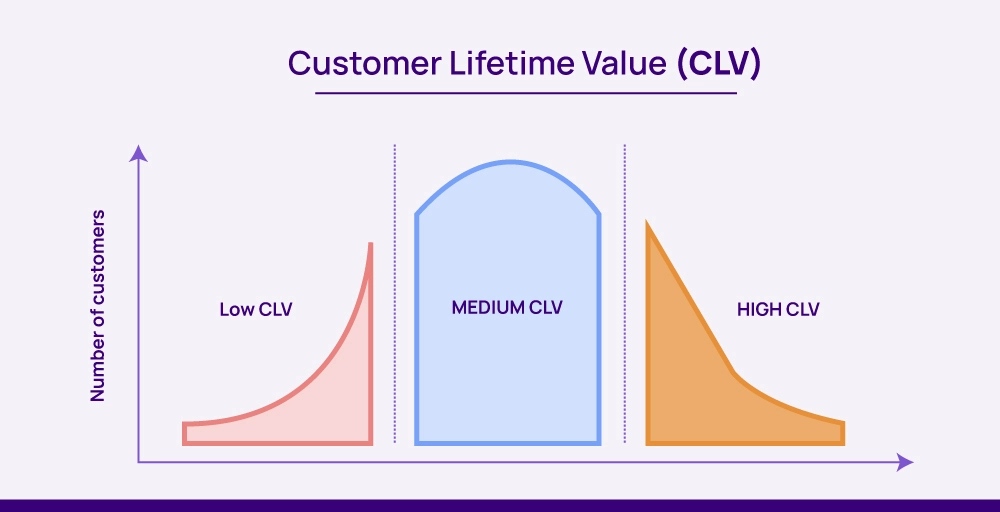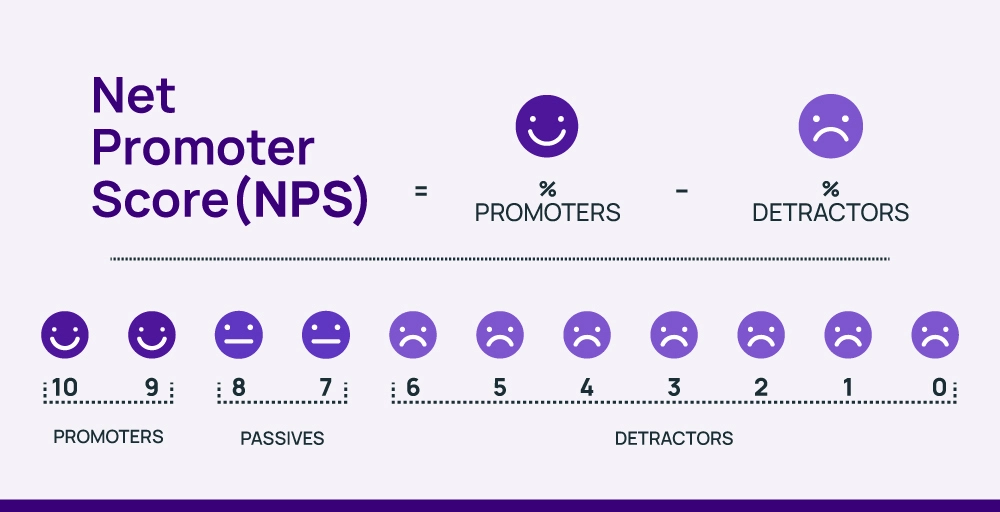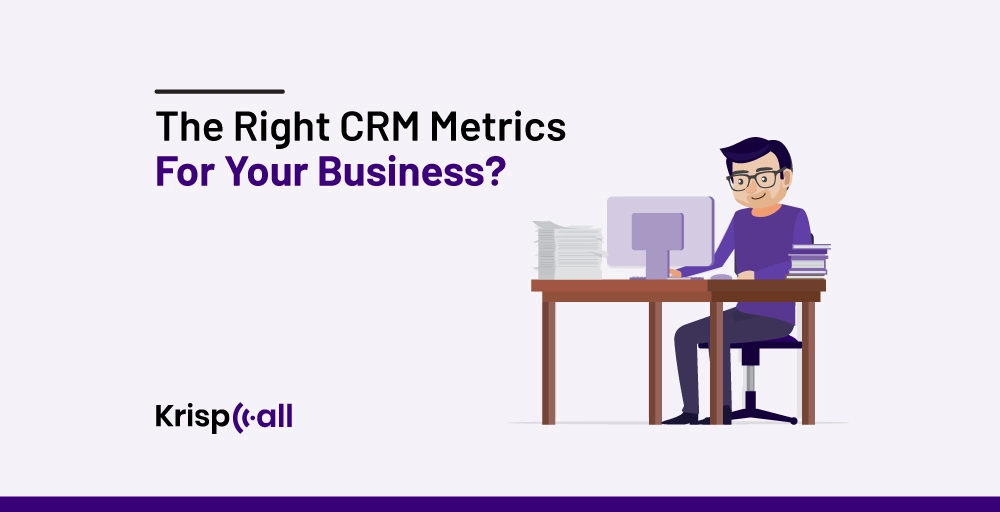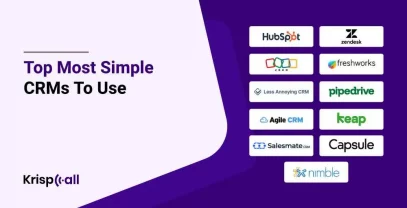Just think 🤔 how useful it would be to know what’s on your customer’s mind. Imagine finding out what they think or feel when engaging with your business. How would this insight transform your approach to marketing, sales, and service delivery?
This extraordinary power ⚡ is now possible because of the CRM metrics.
These metrics are essential data points that indicate the effectiveness of your marketing, sales, and customer support efforts. They measure how well you generate and close deals, retain customers, and increase revenue.
However, not all metrics are important, and not all CRM metrics provide the insights you need. Some are more important for particular situations or industries, and some are easier to measure and monitor.
So, let’s dive 🌊 in and discover the right CRM metrics for your business success, the importance of CRM metrics for your business, and how CRM metrics can improve sales performance in this blog.
🔑KEY HIGHLIGHTS!
- CRM metrics allow businesses to comprehensively assess customer interactions and relationships across acquisition, retention, satisfaction, and profitability.
- Key metrics such as Customer Acquisition Cost (CAC), Customer Lifetime Value (CLV), Customer Retention Rate, Conversion Rate, Net Promoter Score (NPS), and Average Response Time etc play pivotal roles in monitoring and improving different aspects of customer relationship management.
- CRM metrics contribute significantly to business success by enabling performance measurement, providing customer insights, supporting decision-making, facilitating goal setting and tracking, and fostering a culture of continuous improvement. This continuous improvement can lead to significant growth and development within your business.
- Utilizing CRM metrics helps improve sales performance by identifying areas for improvement, optimizing sales processes, setting clear goals, providing targeted training and coaching, and fostering a sense of accountability among sales teams. This accountability can lead to a more committed and responsible sales force.
What are CRM Metrics?
CRM metrics are quantifiable measures companies use to access and monitor customer interactions and behaviors, employee performance, sales, and overall operations. Some popular CRM metrics include Customer Acquisition Rate, Customer Churn Rate, Average Response Time, Customer Enhancement Rate, Net Promoter Score, Sales Growth Rate, etc.
By measuring these CRM metrics, businesses can better understand their customers, optimize their sales and marketing strategies, and grow their businesses. Also, they can make data-driven decisions to drive organizational success by gauging the effectiveness of their relationship management efforts.
Key CRM Metrics for Your Business: Measuring Success in Business
Monitoring CRM metrics is essential for assessing or improving business performance. They provide information about customers’ actions, tastes, and satisfaction levels, facilitating businesses’ making informed decisions, enhancing strategies, and fostering growth and revenues.
The Key CRM metrics for your business that help in measuring business success are:
1. Customer Acquisition Cost (CAC)
Customer Acquisition Cost (CAC) measures the expenses incurred in attracting and converting a new customer, including marketing and sales costs. It helps to evaluate the effectiveness of customer acquisition strategies and determine the return on investment of acquiring new customers.
To calculate CAC, divide the total marketing and sales costs by the number of new customers acquired within a specific period.
Customer Acquisition Cost (CAC)= Total marketing and sales costs / Number of new customers
If the cost to acquire a customer is higher than the average revenue earned from that customer, it can impact profitability. This situation prompts businesses to review their strategies and make necessary adjustments to ensure profitability remains sustainable.
2. Customer Churn Rate
Customer churn rate measures the number of customers who stopped using a certain firm’s goods and services over a given period of time. A high value reveals that many clients are moving to another product or company, which points to problems with people, products, services, or support. Whereas a low rate indicates that customers are satisfied with the company’s products and services.
To measure the churn rate, divide the number of customers lost during a given period by the total number of customers at the start.
Customer churn rate = Number of customers lost during a given period / total number of customers at the start * 100%

To reduce customer churn effectively, businesses can focus on providing superior service, engaging deeply with customers, resolving issues promptly, enhancing customer loyalty, and expanding their services. These steps can help retain customers and foster long-term relationships.
3. Customer Lifetime Value (CLV)
Customer lifetime value (CLV) is another crucial CRM metric that represents the total revenue expected from a single customer over their entire relationship with a business. It highlights the importance of retaining customers, as long-term relationships often yield more value than one-time purchases.
To calculate CLV, multiply the average purchase value by the purchase frequency and the average customer lifespan. Alternatively, businesses can use historical data to predict future revenues based on past profits. Some companies also employ predictive CLV, using machine learning to forecast future transactions from customer behavior patterns.

Businesses can use CLV to allocate resources more efficiently. For example, if a specific customer segment shows a higher CLV, businesses may choose to prioritize efforts there to maximize returns.
4. Customer Retention Rate
Customer retention rate measures customer satisfaction, capturing the number of customers a particular business keeps for a specific period. A high rate means that most customers prefer the particular product, and the company’s revenues are relatively stable. In contrast, a low rate means that attention needs to be paid to various problems, maybe in the quality of the product or services offered.
You can calculate the customer retention rate by finding the percentage of customers who remained with the business over a period of time.
Customer retention rate = Number of customers at the end of the project – the number of customers acquired during the period / Number of customers at the beginning of the period x 100%.
To boost customer loyalty, businesses can enhance client relations, adopt a personalized approach, implement loyalty programs, and actively respond to customer feedback. By focusing on these strategies, companies can strengthen customer relationships and promote sustainable growth.
5. Conversion Rate
Another important CRM metric is conversion rate. It measures the percentage of customers who complete a desired action, like becoming a customer, signing up for a newsletter, or making a purchase on your website. A high conversion rate means that the sales and marketing strategies are effective, while a low rate reveals areas that require enhancement.
To calculate the conversion rate, divide the total number of conversions by the total number of visitors or leads and multiply by 100.
Conversion rate = (Total number of conversions / total number of visitors or leads) x100%
Enhancing website experiences, better CTAs, a friendly check-out, and rewards can increase conversion rates. When businesses use data to refine these strategies, they can achieve higher conversion rates, increased sales, and better marketing returns.
6. Average Response Time
The average response indicates how much time the business agents take to respond to customers. A shorter response time equals excellent services and satisfied customers, while a longer response time equals dissatisfaction among customers and probably losing them.
To determine the average response time, track and calculate the time taken to respond to each inquiry. Businesses can improve this metric by enhancing processes, automating low-value queries, training staff on effective query handling, and using technology like chatbots. Reducing response time boosts customer satisfaction and increases client loyalty.
7. Customer Engagement Rate
The customer engagement rate is one of the important CRM metrics that determines how often customers engage with the business through various platforms. You can use it to gauge how actively customers interact with your brand when they make purchases. A higher rate means high interest and involvement in the product and promotes commitment.
To calculate the engagement rate, divide the number of engaged users by the total number of users, then multiply the result by 100 to get a percentage. Website analytics tools can do this calculation for you.
Promotional activities such as advertisements and social media promotions focus on engagement metrics like likes, shares, and click-through rates to gain insights into customer behavior, preferences, and pain points. This data helps brands tailor personalized customer experiences, enhancing satisfaction and loyalty.
8. Social Media Engagement
Social media engagement measures audience interaction with a business’s content through various social media platforms like Facebook, Instagram, LinkedIn, Twitter, etc. High engagement indicates effective content resonance and community involvement. Businesses track metrics like likes, shares, mentions, direct messages, and comments to gauge engagement effectiveness.
Strategies to boost social media engagement include creating compelling content, encouraging interaction through contests or polls, and fostering genuine conversations to strengthen brand presence and customer relationships.
9. Sales Growth Rate
Growth of sales evaluates the increase in revenue over a specific period due to effective sales strategies and market demand. Positive growth indicates business growth and an improvement in profitability, whereas stagnant or negative growth indicates operations problems or changes in market conditions.
Businesses track sales growth by comparing current revenue with past periods to identify trends and opportunities. Strategies to boost growth include targeted marketing campaigns, optimizing sales procedures, enhancing customer service, and utilizing data analytics for deeper customer insights and responsiveness. Achieving sustained sales growth requires adaptive strategies to meet evolving market demands and maintain competitive advantage.
10. Sales Conversion Cycle
The sales conversion cycle indicates how long it takes to turn a prospect into a product buyer. A shorter cycle implies a better sales process, while a long cycle means problems might affect the product sales process.
The sales conversion cycle is measured by averaging the time it takes to get a lead to close a sale for all sales.
Businesses need to shorten the average sales cycle to boost the sales conversion cycle. They can do this by identifying areas that cause delays and implementing improvements, such as simplifying processes and enhancing follow-up effectiveness. This, in turn, boosts conversion rates and improves overall sales performance.
11. Net Promoter Score (NPS)
Net Promoter Score assesses clients’ loyalty based on the probability of recommending a certain product or service to others. Customers are segmented as Promoters, 9-10 (customers who are highly satisfied and would recommend products), Passives 7-8 (somewhat happy customers who might recommend the product), or Detractors 0-6 (dissatisfied customers who will not recommend the product and even right give bad reviews to others). A high NPS reflects customer loyalty and satisfaction, while a low score signals customer dissatisfaction and issues with products or services.

To calculate the Net Promoter Score (NPS), use this formula;
Net Promoter Score= % of promoters – % of detractors).
Organizations use customer feedback forms to assess the level of NPS, which indicates the state of satisfaction and loyalty of consumers. This CRM metric helps them figure out how to make promoters even happier, address issues with detractors, and improve relationships with passives.
Why are CRM Metrics Important for Your Company?
CRM metrics are important for the company as they help to track the overall company growth and productivity. As a result, a company can make better future plans and improve operations:
- Performance measurement: CRM metrics help track the performance of sales and customer service teams. For example, tracking the number of closed sales each month shows whether sales targets are being met by each agent.
- Customer insights: The CRM metrics provide data on what customers like and how they behave, helping to understand them better and personalize interactions. For instance, analyzing customer purchase history can reveal the most popular products, guiding future product development.
- Decision-making: CRM metrics give important information that helps make smart, data-driven choices. For example, if metrics show that a particular marketing campaign is successful, the company can allocate more resources to similar campaigns.
- Goal setting and tracking: Using CRM metrics, companies can set realistic goals, monitor progress, and adjust plans to achieve these goals. For instance, setting a target to increase customer retention rates by 10% can be tracked through CRM data on repeat purchases.
- Continuous improvement: By analyzing customer feedback and CRM metrics, businesses can identify areas needing attention and strive for ongoing development and improved performance. For example, if customer complaints highlight product flaws, the company can address these issues promptly, thereby enhancing overall customer satisfaction.
How CRM metrics can improve sales performance
The CRM metrics can improve sales performance by:
- Identifying areas for improvement: CRM metrics indicate areas of weakness or the need for increased sales. This assists managers in identifying areas within the sales process that require attention. Therefore, by concentrating on these areas, one can improve general performance.
- Setting goals and targets: CRM metrics help set better and more realistic targets for sales and revenues. Clear goals motivate sales teams and provide a roadmap for achieving success, boosting overall performance.
- Providing training and coaching: CRM data identifies areas where salespeople may need additional training or coaching. Continuous learning helps sales teams sharpen their skills and adapt to evolving challenges, enhancing their effectiveness.
- Fostering accountability: Metrics track individual and team conversions, helping to monitor progress toward targets. This accountability ensures everyone stays focused and productive, driving towards achieving their objectives effectively.
Wrapping Up!
Choosing the right CRM metrics is crucial for effectively managing customer interactions and enhancing business strategies. Metrics such as Customer Acquisition Cost (CAC), Customer Churn Rate, and Customer Lifetime Value (CLV) provide insights into customer behavior, preferences, and satisfaction levels. By diligently monitoring and analyzing these metrics, businesses can pinpoint areas needing improvement, streamline processes, and set realistic goals.
This approach leads to better decision-making, increased customer satisfaction, and, ultimately, higher returns on investment. Calculating CRM metrics is an effective way to drive improvements and ensure long-term growth for the company.
FAQs
What is CRM strategy?
CRM strategy is a plan businesses use to build strong relationships with customers by managing interactions and data effectively to improve satisfaction and loyalty. It integrates technology, processes, and customer data to optimize interactions, improve customer satisfaction, and achieve business goals.
What role does CRM play?
CRM plays a central role in businesses by organizing and leveraging customer data to enhance relationships, streamline operations, and drive growth through personalized marketing, sales, and service strategies. It helps businesses better understand customer needs, improve satisfaction, and increase retention by fostering meaningful interactions and insights.
How can we measure the CRM success?
To measure CRM success, you can track customer satisfaction through surveys and feedback to see how happy they are with your service. Also, monitor retention rates to see how many customers stay with your business over time, which shows loyalty. Lastly, analyze sales growth and repeat business to understand if your CRM efforts increase revenue and encourage customers to return.





